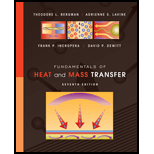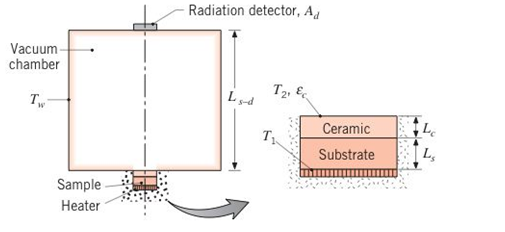
Concept explainers
One scheme for extending the operation of gas turbine blades to higher temperatures involves applying a ceramic coating to the surfaces of blades fabricated from a superalloy such as inconel. To assess the reliability of such coatings, an apparatus has been developed for testing samples under laboratory conditions. The sample is placed at the bottom of a large vacuum chamber whose walls are cryogenically cooled and which is equipped with a radiation detector at the top surface. The detector has a surface area of

Consider conditions for which a ceramic coating of thickness
(a) Consider steady-state conditions for which the bottom surface of the substrate is maintained at
(b) For the prescribed conditions, what is the rate at which radiation emitted by the ceramic is intercepted by the detector?
(c) After repeated experiments, numerous cracks develop at the ceramic−substrate interface, creating an interfacial thermal contact resistance. If
Want to see the full answer?
Check out a sample textbook solution
Chapter 12 Solutions
Fundamentals of Heat and Mass Transfer
- 1.26 Repeat Problem 1.25 but assume that the surface of the storage vessel has an absorbance (equal to the emittance) of 0.1. Then determine the rate of evaporation of the liquid oxygen in kilograms per second and pounds per hour, assuming that convection can be neglected. The heat of vaporization of oxygen at –183°C is .arrow_forwardAs far as diathermy concern, we use microwaves to deposit its energy in the surface of fatty layers where as the infrared waves most of it energy is deposited in deep area with fatty layers. O true Falsearrow_forwardAn infrared camera is used to measure a temperature at a tissue location. The infrared camera uses the same equation as that in the lecture notes. When the total hemispherical emissivity is selected as &=1.0, the temperature reading on the camera is 45°C. (a) Based on the equation given in the notes, please calculate the radiation heat flux received by the camera qck. The Stefan-Boltzmann's constant ois 5.67*108 W/(m²K¹). (b) However, you notice that the actual emissivity of the tissue surface should be 0.95. The room temperature is 20°C. Use the equation again to calculate the temperature of the tissue location, note that qck should be the same as in (a). What is the absolute error of the measurement if both the room temperature and deviation from a perfect blackbody surface are not considered?arrow_forward
- Problem (5): Two concentrating collectors (collector A and collector B) have the same concentration factor of CR = 7 and the optical efficiency of nar = 0.88. The collector temperature for both collectors is 145°C and the ambient air temperature is 27°C. The heat transfer coefficient for collector A is 2.5 W/m2.C and that for collector B is 3.5 W/m2.°C. The solar irradiation on collector A is 600 W/m2. (a) At what solar irradiation rate does collector B have the same efficiency as collector A? (b) What is the efficiency change of collector A when the solar irradiation increases to 900 W/m2?arrow_forwardYou are designing a chamber to contain the radiation emitted by nuclear decay during a fusion reaction. The left face of the (plane) chamber wall (x = 0) is exposed to the radiation and the right face of the wall (x = L) is perfectly insulated. To facilitate the fusion reaction, the left face of the wall is maintained at fixed temperature To. The radiation penetrates the wall causing uniform heat generation that varies with location inside the wall as ) = 40 (1 - 1) g(x) where qo [W/m^3 ] is a constant. Determine an expression for the temperature distribution in the wall T(x) assuming the thermal conductivity of the wall (k) is constant.arrow_forward29. Gamma radiation is bombarding an iron plate as shown in the figure. A con- vection boundary condition of T;= 150 C and h = 200 W/m-K removes heat from the plate. Find the maximum temperature and its location in the plate. Also find temperature at 1 cm from the side facing irradiation and the rate of heat removal from the side not being irradiated. k= 48.5 kW/m K, µ= 24.6 m'. Questions and Problems 507 40 = 19,600 kW/m³ 15 cm T, = 150 C h= 200 W/m K T = 150 C h= 200 W/m Karrow_forward
- 2. A 2-meter section of a 2-cm diameter metal pipe passes through an enclosed furnace. The temperature of the enclosure is at 721 K while the pipe is at 421 K. the emissivity of the metal pipe at 721 K is 0.71 while at 421 K is 0.58. Calculate the heat transfer to the tube by radiation.arrow_forwardA small sphere (emissivity =0.503 radius=r1) is located at the center of a spherical abestos shell ( thickness =1.74 cm, outer radius= r2; thermal conductivity of abestos is 0.090 J/ (sm c degrees) The thickness of the shell is small compared to the inner and outer radii of the shell. The temperature of the small sphere is 695 degrees Celsius while the temperature of the inner surface of the shell is 352 degrees Celsius, both temperatures remaining constant. Assuming that r2/r1 =8.75 and ignoring any air inside the shell, find the temperature in degrees Celsius of the outer surface of the shell.arrow_forwardGive step-by-step calculation and explanation Consider a person sitting nude on a beach in Florida. On a sunny day, visible radiation energy from the sun is absorbed by the person at a rate of 30 kcal/h or 34.9 W. The air temperature is a warm 30 °C and the individual’s skin temperature is 32 °C. The effective body surface exposed to the sun is 0.9 m². (Assume this same area for sun absorption, radiative transfer, and convective loss. Is this a good assumption?) a. Find the net energy gain or loss from thermal radiation each hour. (Assume thermal radiative gain and loss according to the equation 6.51 in Herman and an emissivity of 1.) -(4). Equalion (6.51) - (40Tin)Eskin Aşkin (Tskin – Troom) dt = (4 x 5.67 x 10¬8 w/m²–K* x (307 K)')€skin Askin (Tskin – Troom). (6.52) b. If there is a 4 m/s breeze, find the energy lost by convection each hour. (Use Eq. 6.61 with eq. 6.63.) 1 Equation he(Tskin – Tair), (6.61) A dt he 10.45 – w + 10w0.5 (6.63) - c. If the individual’s metabolic rate is…arrow_forward
- Earth absorbs solar energy and radiates infrared energy. The intensity of the solar radiation incident on earth is J = 1350 Wm-2, also known as the solar constant. Assume earth’s surface (ground) temperature to be uniform at Ts, and that the ground and atmosphere are black (emissivity = 1) for infrared radiation. The radius of the earth is 6.378 x 106 m. The diagram shows the ground at the surface temperature Ts and the atmosphere, represented as a thin black layer, at temperature Ta . Suppose the atmosphere absorbs 100% of the infrared radiation emitted by the ground. Assume that the ground absorbs 47.5% of the incident solar energy, and that the atmosphere absorbs 17.5% of the incident solar energy (for a total of 65% absorbed by the planet). Calculate the "steady state” numerical values of the earth’s ground temperature Ts and the atmospheric temperature Ta taking into account the “greenhouse effect” of atmospheric infrared absorption and emission described above.arrow_forward2. (a) Consider a 25-cm-diameter spherical ball at 700 K suspended in air and assume the emissivity of the ball to be ε=0.95. Calculate: (i) the total emissive power in kW/m2; (ii) the total amount of radiation emitted by the ball in 3 minutes. (b) The inner and outer surfaces of a 25-cm-thick wall are at 27 oC and 45 oC, respectively. The outer surface of the wall exchanges heat by radiation with surrounding surfaces at 40 oC, and convection with ambient air at 42 oC with convection heat transfer coefficient of 9.0 W/m2 K. Solar radiation incident on the surface is at a rate of 150 W/m2. If the emissivity and the solar absorptivity of the outer surface are 0.75 and 0.85, respectively: (i) write the expression of the energy balance at the outer surface;…arrow_forwardTwo compartments in a cylinder with uniform cross section and total length 102 cm are separated by a sliding partition which can move but does not allow heat to pass across it. No molecules are present in either of the compartments. The radiation inside each compartment is in thermal equilibrium with its walls. The walls at the two ends of the cylinder are maintained at temperatures 2000 K and 4000 K, respectively. The sides are perfectly insulated. Find the location of the partition, measured from the left end of the container.arrow_forward
 Principles of Heat Transfer (Activate Learning wi...Mechanical EngineeringISBN:9781305387102Author:Kreith, Frank; Manglik, Raj M.Publisher:Cengage Learning
Principles of Heat Transfer (Activate Learning wi...Mechanical EngineeringISBN:9781305387102Author:Kreith, Frank; Manglik, Raj M.Publisher:Cengage Learning
